Honed Granite vs Polished – Pros and Cons
If you have set your mind on a new kitchen countertop or bathroom vanity, the choice is usually quite easy – most contemporary homeowners pick granite without so much as a second thought. There is a good reason why granite has gained so much popularity over the last several decades:
• It adds stunning elegance and natural beauty to your home décor;
• It comes in a great variety of colors and styles that can match any aesthetic tastes and personal preferences;
• It is known for its exceptional hardness, durability, and ease of maintenanceMaintenance is the routine care, inspection, and repair of a... More;
• It is scratch-proof and heat-resistant, so it can serve as a functional work surface for meal preparationPreparation is the steps taken to ready a property, equipmen... More.
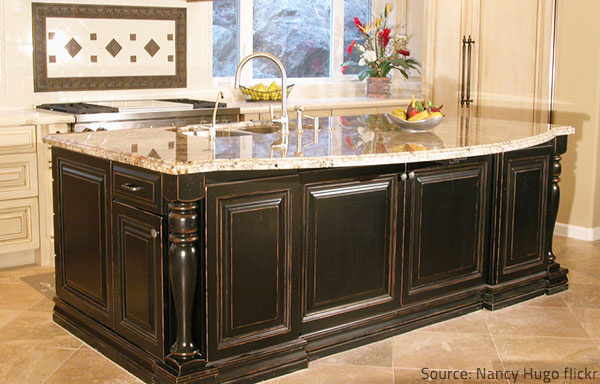
You have a kitchen remodeling project in mind? How about a polished granite countertop?
However beautiful and practical granite may be though, the look and feel of your surroundings, as well as the maintenanceMaintenance is the routine care, inspection, and repair of a... More requirements of the stone, are greatly affected by the particular type of finish you choose for the granite surfaces in your home. Like most natural stones, granite can be finished with different textures and sheens, each of which has its own specifics. To make an informed decision for your new interior design, you need to be aware of the pros and cons of the different types of surface finishes.
So, let’s take a closer look at the key features of the two most popular types of granite finishes – honed granite versus polished granite.
What’s The Difference between Honed and Polished Granite?
The type of surface is determined by where the finishing process ends.
When it comes to granite, the rough stone slab is subjected to a number of finishing processes. The slab first goes through a series of polishing wheels fitted with coarse abrasive pads. These pads apply pressure to the stone, grinding and buffing the surface.
A honed granite finish is created when manufacturers stop the finishing process before the stone surface becomes shiny, leaving it with a satin or matte appearance.
A polished granite finish is created when the stone is buffed with the help of fine polishing pads, causing the surface to acquire a glossy, reflective appearance.
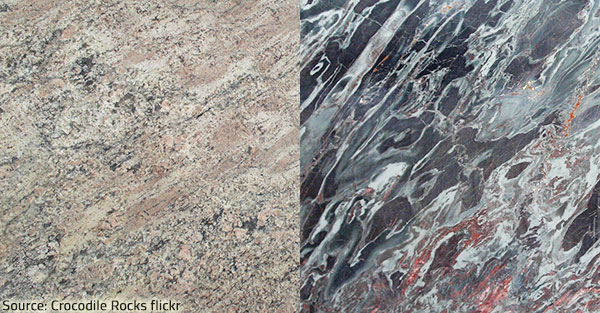
Both honed and polished granite have their significant pros and cons.
Which type of finish will be more appropriate for your home depends on the intended use of the stone and your personal preferences. Here are the main advantages and disadvantages of honed granite and polished granite you need to take into account when making your final choice.
Honed Granite vs Polished: Appearance and Style
Regardless of the finish, granite will impart a unique and elegant look to the ambience, enhancing the overall appeal and value of your home. All you need to do is decide on the type of finish that will better reflect your designer visions and aesthetic ideas.
Polished Granite
If you are looking for a classy, sophisticated appearance, polished granite is your best choice. It reveals all of the granite’s natural beauty and results in unparalleled grandeur and elegance.
Polished granite has a glossy, mirror-like shine that reflects light well and manifests the unique character of your stone. The surface appears smooth and flawless and the colors seem richer and darker. In fact, the polished finish highlights the depth of the stone and makes the colors look crisp and vibrant. You can choose from a great variety of hues, including shades of gold, black, white, and gray.
The polished surface finish is considered the finest finish available. It greatly enhances the richness and elegance of the interior décor and has rightfully become a symbol of opulence and splendor.
Honed Granite
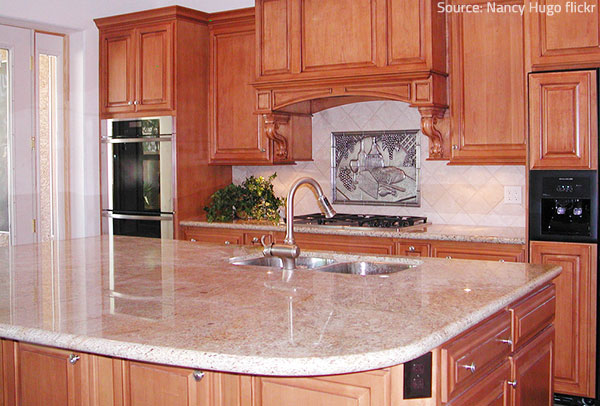
Polished granite has always been a symbol of magnificence and grandeur.
Honed granite surfaces offer a softer, more natural look and feel than polished ones. They evoke a relaxed and casual vibe while still retaining the high class character of the elegant natural stone.
Honed granite can vary in appearance from a matte surface to a low sheen. Its surface is very smooth and velvety to the touch but lacks the shine and the high degree of reflection characteristic of a polished finish. Therefore, it does not show the color and texture of the granite stone as well as a polished finish. Many homeowners, however, prefer this more subtle appearance over the glossiness of polished granite. Besides, honed granite is not as common as its polished counterpart, so it gives your home a unique, cozy look.
In case you like neither the gloss of polished granite, nor the dullness of honed granite, you can use a color enhancer on your honed stone to give it depth and richness.
You can choose from several variations of honed granite finishes, such as satin finish, velvet finish, diamond smooth finish, and machine smooth finish. When shopping for honed granite, have in mind that the degree of honing can vary from slab to slab.
Honed granite is your best option if you are looking for a subtle, contemporary appearance.
Honed Granite vs Polished Granite: Maintenance and Use
The strength of a granite slab does not depend on its finish – regardless of whether you opt for polished granite or honed granite, you will still have durable and valuable stone countertops, backsplashes, stairs, flooring, etc. that will last for many years when properly taken care of.
Polished Granite

You can easily convert your practical granite countertop into a charming dining area – a touch of creativity is all you need.
A polished finish seals or closes most of the pores on the stone surface, making it very sanitary, easy to clean, and stain-resistant. Since polished granite is not as porousPorous describes a material that contains small openings or ... More as other surface finishes, it won’t require frequent resealing.
The polished stone easily repels moisture and doesn’t harbor bacteria, so it is an exceptional choice for food preparationPreparation is the steps taken to ready a property, equipmen... More areas, such as kitchen counters and tabletops. Polished granite surfaces are not only beautiful and practical, but also quite versatile – a polished-granite island, for example, is the focal point of the kitchen because of its elegant and impressive appearance, serves as an excellent meal preparationPreparation is the steps taken to ready a property, equipmen... More surface because of its resistance to heat, scratches and stains, and can be instantly converted into a serving or dining space whenever necessary.
Apart from countertops and vanities, polished granite can also be incorporated into flooring to impart a more formal and elegant style to the surroundings and elevate the richness of your home décor.
Polished granite is an excellent choice for areas that receive a lot of daily use and heavy traffic, as the finish requires little maintenanceMaintenance is the routine care, inspection, and repair of a... More and is very likely to resist stains and other signs of wear and tear. In fact, polished granite is nearly impervious to weather and chemical wear.
Honed Granite
Honed surfaces are smooth but much more porousPorous describes a material that contains small openings or ... More than polished ones. Therefore, even when treated with a sealant, honed granite is quite susceptible to staining – when spilled on the surface, strongly colored food and drinks can leave stains and leadLead is a heavy metal that can be toxic to humans, especiall... More to dark spots or discoloration. Acidic liquids like fruit juices, alcoholic beverages, and soda may even etch the surface. To prevent honed granite from absorbing water and staining too easily, you need to reseal it rather frequently – preferably, every few months.
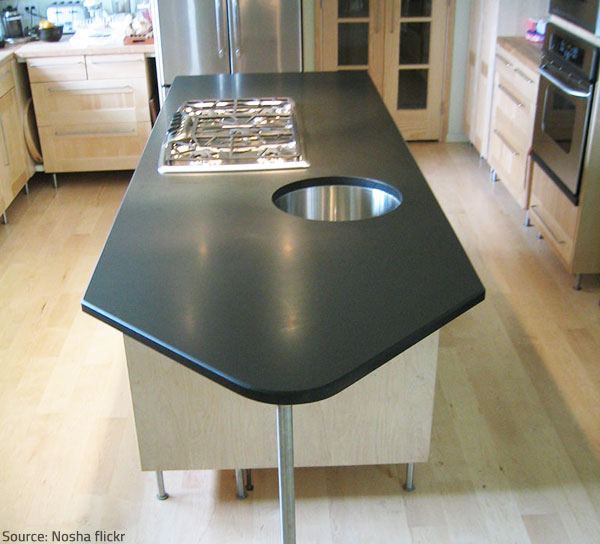
Honed granite gives your home a unique, contemporary look.
All in all, honed granite requires more maintenanceMaintenance is the routine care, inspection, and repair of a... More than its polished counterpart. Have in mind that dust, grease, and hand imprints will be very apparent on the honed surface and quite difficult to remove (a color enhancer can help minimize the dark spots and fingerprints). Be careful to use only safe and recommended cleaning products to clean the honed granite in your home. Remember to wipe the surfaces daily with a damp cloth and dry them thoroughly with a towel to prevent water spots.
Honed surfaces are less slippery than polished ones, so honed granite is mainly used for floors, stairs and other areas where water might be present and pose a risk of falling. Honed surfaces are also preferred for high-traffic areas where heavy foot traffic may cause a polished finish to wear off or deteriorate too quickly (a honed finish is less likely to show evidence of traffic patterns or wearing).
In addition to flooring, honed granite can be used for countertops and backsplashes whenever a more subtle appearance is preferred over the shiny look of polished granite.
Honed vs Polished Granite: Cost
Is honed granite more expensive than polished granite? Is the cost of polished granite higher? The price of granite varies depending on a number of factors – availability, place of origin, type of finish, rarity of colors and patterns, etc.
Polished granite requires more grinding than honed granite, so it makes sense for the polished stone to be more expensive than its honed counterpart. However, polished finishes are very popular and therefore – very likely to be in stock. As a result, polish granite tends to be cheaper than honed granite because of its high availability. An uncommon finish that requires a special order may cost more, even if the production process is simpler.
What Is Better – Honed or Polished Granite?
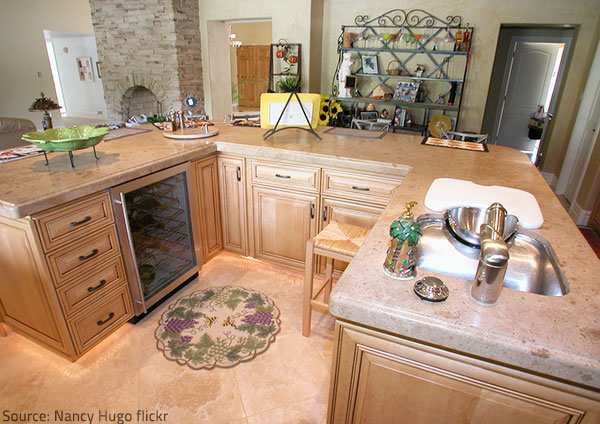
Have you already decided on the best type of granite finish for your home?
So, honed or polished granite? There is no definite answer – both types of finishes have their pros and cons. The choice depends entirely on your personal taste and the specifics of your home environment. Just make sure you gather all the important information, read online customer reviews, compare prices and maintenanceMaintenance is the routine care, inspection, and repair of a... More requirements, and see some samples before making your final decision.
By selecting granite, whether honed or polished, you get the durability and longevity of a high-performance natural stone. The different types of finishes allow you to capitalize on the beauty and functionality of granite in a way that perfectly suits your needs and aesthetic preferences, as well as your overall home decor.












